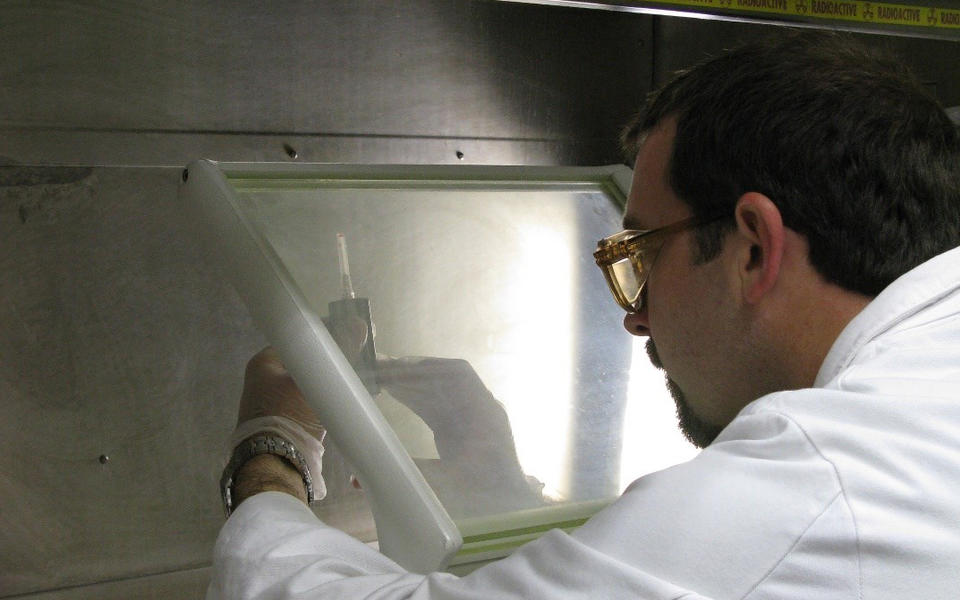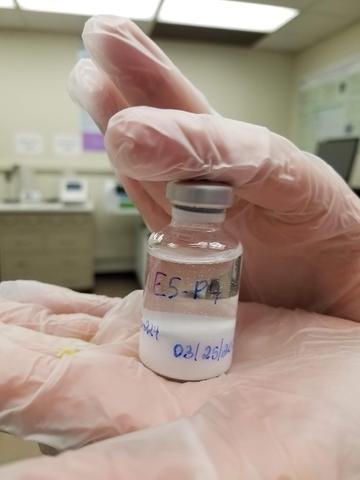Taking Measure
Just a Standard Blog

Working behind an L-shield with a syringe containing a radiopharmaceutical.
From the earliest days of radioactivity research, radiation and cancer therapy have gone together like peas and carrots. But Zach Levine covered peas and carrots in an earlier blog post, so I will focus on radiation and cancer therapy.
Shortly after Wilhelm Röntgen discovered the high-energy electromagnetic radiation he called “X-rays” in 1895, their cell-killing power was recognized and harnessed to treat cancer. Similarly, within a few years of the Curies’ discovery of the radioactive element radium, doctors were deploying the energetic particles it emitted to treat skin cancers. By the 1910s, more powerful X-ray tubes were producing beams that could penetrate deeper into the body to treat all sorts of tumors. This “external beam therapy” was on its way to becoming the standard for radiotherapy, largely supplanting radium-based therapies.
Today, with creative chemistry, radium isotopes (along with radioactive isotopes of other atoms) are making a comeback. Modern external beam approaches are pretty good at limiting damage to healthy neighboring tissue, but it’s a struggle. Emerging alternative therapies use the heaviest of the particles emitted by radioactive isotopes, called alpha particles, which deliver lethal amounts of energy to precisely targeted tissue over very short ranges.
Before diving too deep into how “alpha therapy” works, I should probably step back to define “alpha particle.” It’s not something most people — even most scientists — think about regularly. In fact, I vividly recall a feeling of panic in 2008 when, on my way to my new office in the Radiation Physics Building at the National Institute of Standards and Technology (NIST), I realized I wasn’t 100% confident I correctly remembered which were the alphas, the betas and the gammas! Which were the big ones? How did I get here?
The answer to that last question was “bowling,” by the way. You see, I came to NIST in 2006 as a National Research Council (NRC) fellow to study how gold nanoparticles form. I joined the NIST bowling league within a week of arriving, while my wife and I were still living in a hotel room. As my fellowship was ending two years later, I was in the thick of a job hunt, and I was still bowling. So was (now retired) Radioactivity Group leader Mike Unterweger, who asked me, “Are you afraid of radioactivity?” I answered “No … ,” sent Mike my CV, and soon found myself intrigued by an opportunity to dive into a totally new (to me) field.

By this time, you’re thinking I’ve digressed, gone off the rails, and there’s no coming back. But wait! I’ll use bowling to help illustrate an important concept. It’s called “linear energy transfer,” and it matters a lot in targeted radiotherapy. Until a few years ago, radioactive drugs used in cancer therapy (“therapeutic radiopharmaceuticals,” usually molecules or particles tagged with a radioactive payload and designed to target cancer in different areas of the body) were mostly based on beta emitters. Beta particles are high-energy electrons given off when a neutron in an atomic nucleus decays into a proton. In cancer therapy, a beta particle bounces around in tissue, losing energy as it scatters. It will typically travel a centimeter or so before losing all its energy. Along the way, chemical bonds are broken, meaning some cells can be killed. Let’s picture a 6-pound bowling ball rattling around as it knocks down a few pins. Cute.
But what if you can put a 16-pound ball right in the pocket? (Strike!!) That’s targeted alpha therapy. Instead of a lightweight electron, an alpha particle is a highly charged helium nucleus (two protons and two neutrons), about 8,000 times as massive and delivering all its considerable kinetic energy over a few micrometers. An alpha particle will utterly destroy everything in its short path. That’s high linear energy transfer.

Smart chemists have been figuring out ways to deliver alpha-particle-emitting radiopharmaceuticals directly to the cells they wish to kill. If everything goes to plan, this approach means killing all the tumor cells without causing any damage to neighboring healthy tissue. This is a step toward the dream of side-effect-free cancer therapy.
Where does NIST come in? To administer an optimal therapeutic dose, you need to establish a dose-response relationship. While we leave the “response” part to our colleagues in the clinic, the “dose” part comes back to us. And while “dose” is defined in terms of absorbed energy per kilogram (measured in grays), the amount of dose-delivering radioactivity administered to a patient is measured in becquerels.
The becquerel is the SI unit for activity, defined as the number of decays of a particular radionuclide per second. Every radionuclide disintegrates via its own unique decay scheme, meaning that every radionuclide effectively has its own becquerel. And, of course, since our radioactive samples are always decaying away (i.e., they’re radioactive), a measurement of the becquerel is only meaningful when it’s accompanied by a reference time. Along with the activity of my sample right now, I have to tell you what I mean by “right now” and I have to tell you the half-life (the amount of time it takes for half of the atoms to decay) of the particular radionuclide in my sample. Only then can you figure out what activity to expect of my sample when it matters to you. The becquerel is a tricky, ethereal beast. It’s our job at NIST to define that beast as precisely as possible to support all sorts of applications, including therapeutic nuclear medicine.

As I said, alphas deliver their energy over a very short range, making them “easy” to measure with certain techniques. But don’t worry! There’s enough physics and chemistry here to really keep us on our toes. Some of our biggest challenges come from the complex decay chains we’re encountering. Alpha-emitting isotopes such as radium-223, radium-224 and actinium-211 don’t just spit out an alpha particle and become stable. They decay into atoms that then decay into other atoms that then … you get the idea. They stay radioactive. We have to account for all of the radionuclides in a series of decays in order to measure the activity of the first one. And we do. Using a scheme referred to as the “Bateman equation,” we predict the relative activities of every member in a decay chain (often called the “parent” and its “progeny”) at any given time. With that, and good knowledge of the characteristic radiation of all the progeny, we can make very precise activity measurements.
Increasingly, NIST is asked to set the standards that will support clinical activity measurements for alpha-emitters. Our measurements will power a new age of precision medicine, making sure that just the right amount of radiation gets just where it needs to be to kill every cancer cell.
A few years back, at a meeting of the Society of Nuclear Medicine and Molecular Imaging, I sat in on a patient education session that focused on a drug product our group at NIST had worked on. During the Q&A part of the session, a couple of cancer survivors shared their stories, explaining how joining a particular clinical trial had radically changed their lives. I work in a lab, trying to figure out how to solve measurement problems, thinking about some chemistry and some nuclear physics — I had never really given much thought to the individuals on the other end. A year ago, they’d suffered crippling pain and a hopeless prognosis. But here they were, alive and traveling across the country to share their stories at this meeting. The impact NIST measurements can have on people’s lives is … striking.
About the author
Related Posts
Comments
Thanks for writing, Sharlene, and best wishes for success with your therapy.
Thank you sincerely for your dedication and work. I have just been diagnosed with angiosarcoma, a more cellular rather then a tumor cancer. Your research sounds promising towards a novel treatment of this rare cancer. I'm hopefully your success will lead to procedures that can save lives.
Thankyou, seriously, for your dedication and work. I have been diagnosed recently with angiosarcoma, a more cellular rather then tumor cancer. Your research looks promising in developing protocol and procedures in treating this type of cancer. Hopefully your research will someday provide hope to people experiencing this type of aggressive and terminal cancer. Keep up the dedication.
Thanks, John. I can only share your hope that molecular targeting will lead to effective therapies for this type of cancer.
Thank you for your hard work, Denis! Brilliant scientists like you are the future of our country. Please know that we appreciate your hard work and dedication for making a better world for us!
Thanks!
I did not directly benefit from your research, and I pray I don't have to, but your work will help many people immeasurably. Because of dedicated people just like yourself, that saw me through a battle with breast cancer, I was able to see my son graduate middle school and high school. He was able to have his mom hug him each time and everyday ever since. We thank you, immeasurably!






Thank you for your work! Hoping my radiation therapy will be done before your research is complete, but really hoping that if I should have a recurrence in the future your work will be done and ready to go! It is so encouraging to know that there are scientists working on this area of treatment. There are so many of us that have needed it!